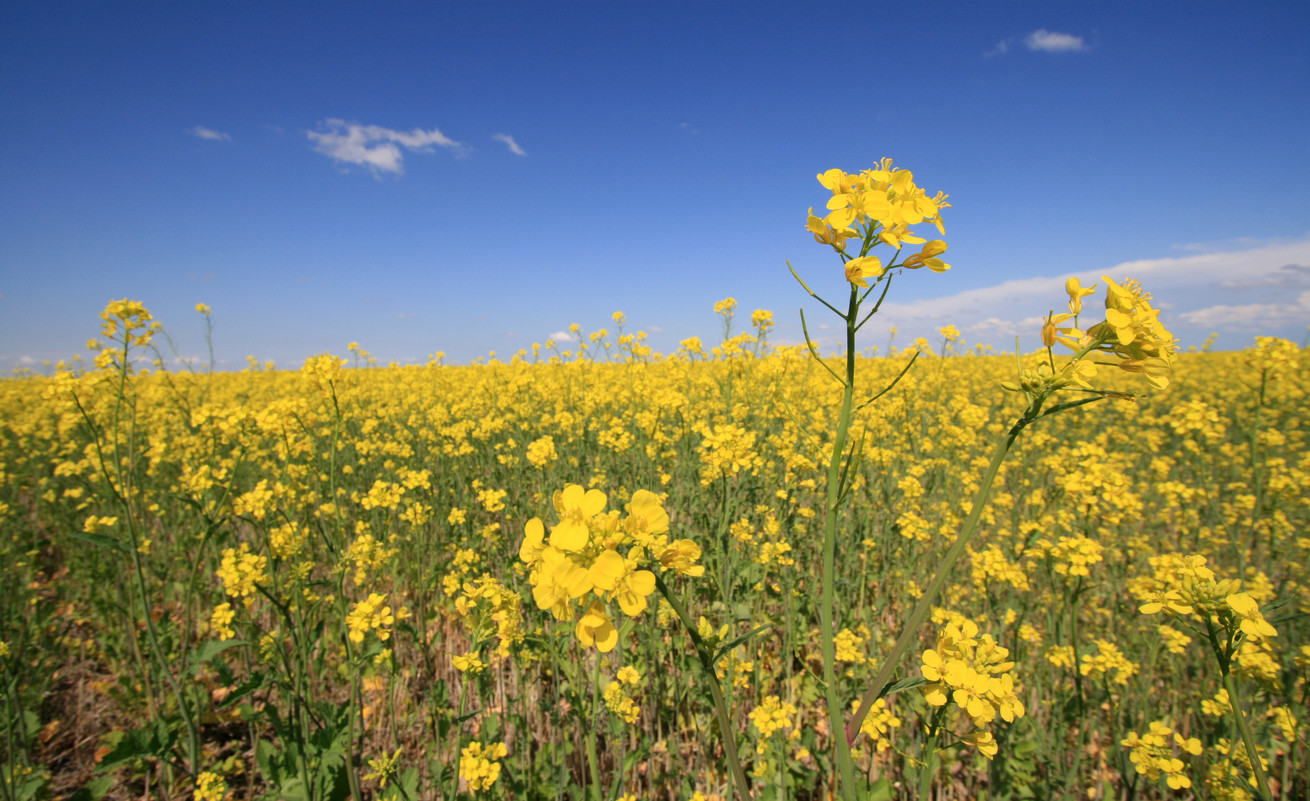
UNIVERSITY OF CALGARY SCIENTISTS IDENTIFY KEY CANOLA PROTEIN INVOLVED IN POLLINATION
Aug 02, 2022

U OF C RESEARCH LOOKS TO INCREASE SEED PROTEIN BY 20%
Aug 02, 2022
Intersection of science and entrepreneurship hits a particular sweet spot at the university
By Kathy Kerr
PhD student Logan Skori and Prof. Marcus Samuel are pushing the University of Calgary into the forefront of plant-protein research from the ground up.
Intersection of science and entrepreneurship hits a particular sweet spot at the university
By Kathy Kerr
PhD student Logan Skori and Prof. Marcus Samuel are pushing the University of Calgary into the forefront of plant-protein research from the ground up.
Skori is working on genetic technology to increase seed protein by 20 per cent. With early results in canola, he and Samuel hope the technique will apply to pulse crops, where the protein boost would be a huge improvement for farmers.
Marcus Samuel
“I see great potential for Alberta to be one of the leaders in this space,” says Samuel. “Right now, there are independent pockets working on different aspects of protein technology but if you connect us with Lingyun Chen (researcher at the University of Alberta), with (Calgary-based firm) Botaneco, we can achieve something really significant in this space.”
Several faculties and programs at the U of C touch on the plant-protein and agribusiness sectors, spanning pure plant research, turning out graduates who will work in the sector and help entrepreneurs grow their ventures.
Samuel and Skori in the Department of Biological Science have been researching ways to make seeds, particularly canola, more drought and late-frost tolerant and to make other improvements to their characteristics.
“In part of my PhD research we have been looking at different genes that are important in seed development,” says Skori. “And with one of the genes we worked with, we noticed there was about a 20 per cent increase in seed protein.”
The researchers begin their genetic work by gene modification but since GMO products are not marketable in Europe, they then applied genetic editing to try to reach the same results. Gene-edited food is accepted in the U.S. and Samuel hopes the EU will soon accept it as well since no material foreign to the plant is included in the modification.
Logan Skori
“We can take any target genes we want to alter, put them into a gene-editing program and we are able to look at different parameters like seed protein,” says Skori.
Samuel says legal experts at the university think their discovery is a protectable technology.
“The big thing would be securing the IP (intellectual property protection) as a technology that could be integrated into different crops,” says Skori.
“Once we go down that trail then I think different companies or seed growers may reach out and say, ‘Can this be applied to a soybean or a chickpea?’ And we can start working with different companies to help them develop a protocol.”
Skori would own the IP with the university. He hopes to form his own company to commercialize the technology.
It’s that intersection of science and entrepreneurship that hits a particular sweet spot at the U of C.
On the other end of the commercialization continuum from the science faculty’s biological research, Creative Destruction Lab (Rockies) is a program for entrepreneurs embedded at the U of C’s Haskayne School of Business that can help early-stage businesses.
Kari Gordon
Kari Gordon, programming director at CDL, says the program added an agriculture stream this year to its school for entrepreneurs.
Businesses who are accepted to the program are “anywhere from validation of prototype right through to early revenue,” says Gordon.
“We love founding ventures or startups that have IP that is part of their process or they have trade secrets. Then they would come to us if they are looking into how to enter into a market, how to grow from a prototype and begin to scale their product.”
The nine-month program is intense and not everyone finishes the program, says Gordon. Entrepreneurs must be committed to invest the time and meet objectives throughout the nine months. The non-profit CDL doesn’t charge fees or take equity in the ventures it guides.
Gordon says in this first year of the ag stream of the program, more than 75 companies applied for 20 spots.
The program is divided into eight-week sessions, with three objectives to be met during each session. Expert business mentors provide guidance along the way. In pre-COVID times the entrepreneurs would meet one day out of each of those sessions for face-to-face meetings but this year virtual meetings are necessary.
CDL student entrepreneurs are also exposed to venture capital providers and CDL’s business partners who “may be first customers or partners for a pilot program,” says Gordon.
Amita Massey
There are other routes for students to leverage the U of C’s emphasis on entrepreneurship.
Therakesh MM already had a business venture in India before coming to the U of C. Red Agro focused on supply chain and logistics for agribusiness.
That company is on hold as Therakesh now works on his MBA at the Haskayne School of Business.
He says he continues to be interested in the logistics topic during his MBA. “I’m still exploring options and talking to different retailers and wholesalers to see what proteins and products we can bring from different parts of the world, and also to understand what we can do to the supply chains to optimize that.”
Amita Massey is already an entrepreneur in the food industry. Her Foodglow venture, started two and a half years ago, is a home-based business producing healthy protein-focused snack foods, including muffins and fudge, and a protein powder.
Massey began with sales through fitness studios and now her products are carried in health food stores in Calgary.
She is in her fourth year of kinesiology studies at the U of C.
“It’s really nice to be able to tell people I have that backing in sport and human performance.”
Kathy Kerr is a freelance writer and editor
This story is part of a series on post-secondary institutions in Alberta:
Posted Oct. 20, 2020
